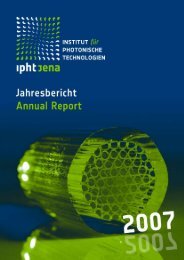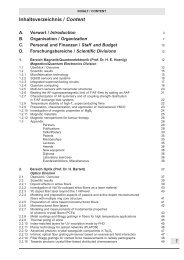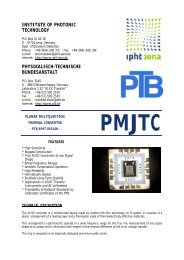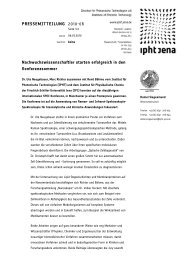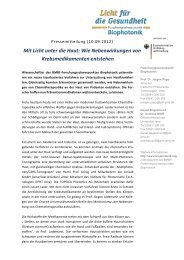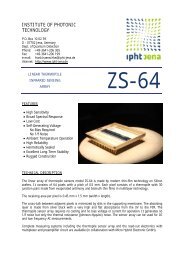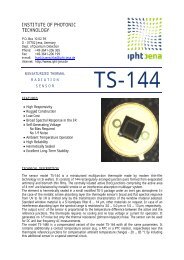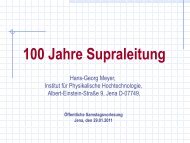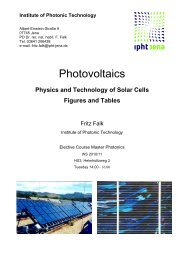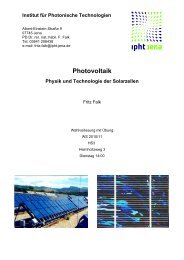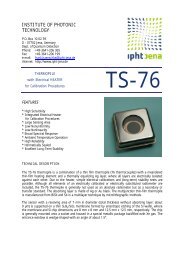Jahresbericht 2005 - IPHT Jena
Jahresbericht 2005 - IPHT Jena
Jahresbericht 2005 - IPHT Jena
Create successful ePaper yourself
Turn your PDF publications into a flip-book with our unique Google optimized e-Paper software.
82<br />
Die Abteilung Laserchemie arbeitet zum größten<br />
Teil auf dem Gebiet der Solarzellen (Design und<br />
Herstellung) und ist in der Photovoltaik(PV) fest<br />
verankert, in F&E-Fachkreisen (z.B. PVUniNetz<br />
und Solar INPUT) und Industriepartnerschaften<br />
(z.B. Firma Ersol, Erfurt und Antec Solar, Arnstadt).<br />
Herausragendes Projektergebnis im Jahr<br />
<strong>2005</strong> ist die produktionsnahe Präparation von<br />
Silizium-Kristallkeimschichten mit einem industrietauglichen<br />
Diodenlasersystem, das neben<br />
einer deutlichen Kapazitätssteigerung durch eine<br />
Laserleistung von 0,7 kW gegenüber 10–20 W<br />
aus einem Ar + -Laser auch eine Kristallkeimvergrößerung<br />
von 0,01–0,1 mm auf 0,1 bis wenige<br />
mm bewirkt (s. Farbbildseite).<br />
In enger Zusammenarbeit mit dem Institut für<br />
Festkörperphysik der Friedrich-Schiller-Universität,<br />
dem MPI für Mikrostrukturphysik, Halle und<br />
der Uníversität Halle ist das neue Arbeitsfeld mit<br />
nanostrukturierten Halbleitern auf eine breitere<br />
Basis gestellt worden. Zu der bereits 2004 etablierten<br />
CVD-Methode sind zur Präparation von<br />
Nanodrähten aus Silizium die Elektronenstrahlverdampfung<br />
und die Laserablation hinzugekommen.<br />
Inzwischen gelingt es, Nanodrähte in<br />
Vorzugsrichtungen wachsen zu lassen (Abb. 4.2).<br />
Die Abteilung Laserdiagnostik hat ihre Methodenvielfalt<br />
um die Frequenzverdopplung (SHG =<br />
second harmonic generation) von Femtosekundenlaserpulsen<br />
an Grenzflächen erweitert (Doktorarbeit<br />
T. Scheidt „summa cum laude“, vgl. auch<br />
Abb. 4.6) und kann damit selbst monomolekulare<br />
Dünnschichten diagnostizieren. Die an optischen<br />
Massivmaterialien erprobten Transmissions- und<br />
Absorptionsmessungen haben mit der Doktorarbeit<br />
von Ch. Mühlig („magna cum laude“) einen<br />
neuen Qualitätsstandard erreicht (Abb. 4.4 und<br />
4.5). Absorptionsmessungen mit Teststrahlablenkung<br />
(LID = laser induced deflection) und die<br />
laserinduzierte Fluoreszenz (LIF) gelingen zunehmend<br />
auch an Dünnschichten und optischen<br />
Komponenten durch Empfindlichkeitssteigerungen<br />
und/oder Konzeptverbesserungen der Messmethoden.<br />
Die Entwicklung des Scheibenlasersystems<br />
(ADL-FT = Advanced Disk Laser für Fallturm)<br />
machte <strong>2005</strong> – in bewährter Zusammenarbeit mit<br />
dem IFSW (Stuttgart) und ZARM (Bremen) –<br />
große Fortschritte. Die Ergebnisse aus den<br />
ersten Fallturm-Abwürfen haben inzwischen zu<br />
Konzeptverbesserungen geführt. Im <strong>IPHT</strong> gelang<br />
mit diesem Lasertyp auch die kurzwellige Anregung<br />
von OH-Radikalen für die Flammendiagnostik,<br />
in Zusammenarbeit mit dem Bereich<br />
Mikrosysteme auch an Mikroflammen (ca. 5 mm<br />
breit, 35 mm hoch, Abb. 4.7). In Kooperation mit<br />
dem Bereich Optik gelang auch die Laserdiagnostik<br />
an Partikel-„beladenen“ Flammen, die beispielsweise<br />
zur Glassynthese dienen.<br />
LASERTECHNIK / LASER TECHNOLOGY<br />
voltaics R&D community (e.g. PVUniNetz and<br />
Solar INPUT) and in industrial partnerships (e.g.<br />
Ersol company, Erfurt and Antec Solar, Arnstadt).<br />
The prominent success in <strong>2005</strong> consists of the<br />
production relevant preparation of silicon crystalline<br />
seed layers with a laser diode system suitable<br />
for industrial application. Not only was<br />
the throughput increased by using a 0.7 kW<br />
diode laser instead of the previous 10–20 W Ar +<br />
laser but also an enlargement of the crystallite<br />
size from 0.01–0.1 mm to 0.1–several mm was<br />
achieved (cf. coloured page).<br />
In close cooperation with the Institute of Solid<br />
State Physics at the Friedrich-Schiller-University,<br />
the Max-Planck-Institute of Microstructural Physics<br />
at Halle and the University of Halle, the new field<br />
of nanostructured semiconductors has been put<br />
onto an enlarged basis. The CVD method available<br />
in 2004 for nanowire preparation has been<br />
complemented by electron beam evaporation<br />
and laser ablation of silicon. Meanwhile we manage<br />
to grow epitaxial nanowires into preferred<br />
directions (Fig. 4.2).<br />
The Laser Diagnostics section has added frequency<br />
doubling (SHG = second harmonic generation)<br />
of femtosecond laser pulses on surfaces<br />
to its variety of experimental methods (PhD thesis<br />
of T. Scheidt “summa cum laude”, also cf.<br />
Fig. 4.6) enabling to characterize even monomolecular<br />
thin layers. The transmission and absorption<br />
measurement methods established with optical<br />
bulk materials achieved a new quality standard<br />
(PhD thesis of Ch. Mühlig, “magna cum<br />
laude”, also cf. Figs. 4.4 and 4.5). Absorption<br />
measurements with laser induced deflection<br />
(LID) of a probe beam and the laser induced fluorescence<br />
(LIF) now can more and more be<br />
transferred to thin films and optical components<br />
due to sensitivity enhancements and/or improved<br />
concepts of the measurement methods.<br />
The development of the disk laser system (ADL<br />
FT = Advanced Disk Laser for “Fallturm”) showed<br />
– in the experienced cooperation with IFSW<br />
(Stuttgart) and ZARM (Bremen) – much progress<br />
in <strong>2005</strong>. The results of the first experiments in the<br />
drop tower meanwhile induced several conceptual<br />
improvements. At <strong>IPHT</strong>, experiments with this<br />
kind of laser were performed at short wavelengths<br />
suitable to excite OH radicals in flames, in<br />
cooperation with the division for Microsystems<br />
even in microflames (5 mm broad, 35 mm high,<br />
Fig. 4.7). In cooperation with the Optics division<br />
laser diagnostics could be shown for particle<br />
“loaded” flames suitable e.g. for glass synthesis.<br />
Due to the extraordinary efforts of all coworkers<br />
during <strong>2005</strong> the division for Laser Technology<br />
managed to nearly maintain its project funds,<br />
level of publications, and patents in spite of the<br />
tough situation with governmental funds and the



